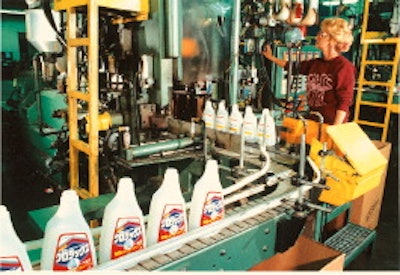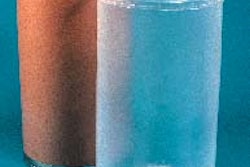If an environmentally conscious company has already lightweighted certain bottles as much as the laws of physics will allow, how does that company make its bottles even "greener"? For Clorox, the answer was to work closely with bottle supplier Owens-Brockway (Toledo, OH) to develop high-density polyethylene bottles that contain 25% post-consumer recycled (PCR) material yet still maintain top-load strength and chemical resistance. The bottles were developed for 16-, 22- and 32-oz sizes of Tilex®, Formula 409® and other liquid household cleansers. The initiative was launched several years ago when California and Oregon decreed that if rigid plastic containers could be recycled at a rate of 25%, further environmental laws governing such containers would not be needed. If that goal were not met, however, companies would have three options. They could lightweight containers by 10% compared to weights in 1990, use containers that can be refilled five times before disposal, or incorporate at least 25% PCR material. Lightweighting was no option for Clorox because the firm had already squeezed from its bottles every gram of resin it could. As for reusable plastic containers, they're practically unheard of in this country. So PCR became the option for Clorox, an option the firm continued to pursue even when no longer obligated to do it. The recycling rate for rigid plastic containers reached the magic level of 25% last year in both California and Oregon, thus eliminating any other environmental packaging requirements. Development of the new bottle took three years, but by 1995 it was implemented commercially in all Owens-Brockway bottles containing Clorox household cleansers. A technical challenge Getting the PCR into Clorox's household cleanser bottles was no simple task, says Jim Fargher, director of research and development at Owens-Brockway. "The common source of PCR is recycled HDPE milk containers," says Fargher. "The HDPE used to make milk bottles is a homopolymer grade that does not have good environmental stress- crack resistance (ESCR), and without good ESCR the container won't resist chemical attack. To compensate for the use of PCR, we had to find a strong virgin HDPE grade that would provide more than normal ESCR to keep the bottle from failing when stored on the shelf for a period of time." The grade selected by Owens-Brockway was Marlex® C590 HDPE from Phillips Chemical Co. (Bartlesville, OK). Phillips claims the material has shown in tests that it has an ESCR value up to 200% higher than other resins with the same 0.955 g/cc density. "Bleach-based products are difficult to hold, and adding PCR to the mix only reduces the bottle's resistance to chemical attack," says Fargher. "Marlex C590 strengthens the mix better than other resins we tested." One relatively simple way of improving ESCR, says Don Brady, general manager of Phillips' Marlex polyethylene business, is to lower the density from 0.955 g/cc, the industry standard, to somewhere between 0.950 and 0.952 g/cc. But while this yields better ESCR, it comes at the expense of top-load strength. So Phillips took a different approach. "We used a new catalyst developed by our research and development team," says Brady. "By making the most of our reactor technology, we retained a density of 0.955 g/cc." From a blend of PCR and virgin C590, bottles are molded and labeled in the mold, for domestic and overseas use, mainly at the Owens-Brockway plant in Atlanta. It supports a nearby Clorox plant. According to Owens-Brockway, the new bottles are priced at parity with the pre-PCR bottles. "At one point Clorox didn't feel they could put PCR in a package unless it was used as the middle layer of a three-layer bottle," recalls Fargher. "Their concern with monolayer was two-fold: that con-tamination in the PCR would cause their product to degrade, and that homopolymer PCR on the inside surface would cause the container to fail. Cleaner PCR solved the first problem, and the use of Marlex C590 prevented container failure." Combined technologies The Clorox bottles are produced on Owens-Brockway's BC-3 machinery. It's neither a wheel nor a shuttle system. According to Fargher, it's an "intermittent motion extrusion blow molding machine." It combines injection and blow molding technologies to produce a bottle that can be made at extrusion blow molding rates yet whose neck finish has the tight tolerances of an injection-molded container. "It's unique," says Fargher. "You injection mold the finish first, then a tube is extruded and blown into the bottle. The material at the point where the tube is quickly extruded needs to be tough because there is a sudden acceleration of material flow there. The material needs to withstand that jolt without separating, and conventional resins combined with PCR from milk bottles weren't up to it. As soon as we used the C590, our extrusion problems disappeared." The in-mold labels applied to the Clorox bottles come from a variety of outside vendors determined by Clorox. As for the PCR, Owens-Brockway purchases it from the Phillips Plastics Recycling Co. in Tulsa, OK. The 40 million-pound-a-year facility had an automated sorting system installed in April '96 to further enhance its ability to provide PCR HDPE of the caliber needed by Owens-Brockway. Though pleased with the amount of PCR currently used in its household cleanser bottles produced by Owens-Brockway, Clorox hasn't ruled out the possibility of increasing the percentage. "By using Marlex C590 HDPE, we have the capability to do just that," says Kevin Stevens, household products marketing manager for Owens-Brockway. But already Clorox has posted some pretty impressive numbers where PCR usage is concerned. In 1995, the year Owens-Brockway began making Clorox household cleanser bottles with 25% PCR, Clorox doubled its total use of PCR to 16 million pounds annually. According to Clorox, that's enough resin to produce 74 million gallon-size bleach bottles.


























